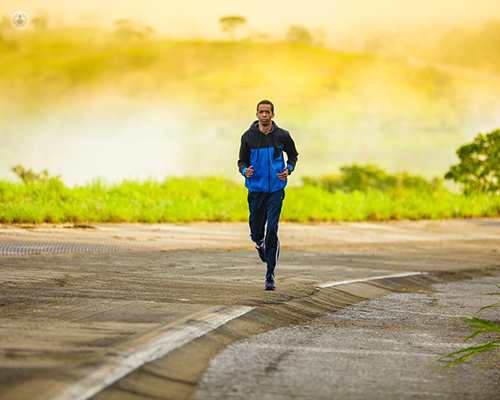Bursitis: types, symptoms and treatment
Escrito por:Bursitis occurs when the fluid-filled sacs (bursa) that cushion your joints such as the shoulders, hips, elbows or knees, becomes inflamed. Here, one of our expert orthopaedic surgeons Mr Jonathan Walczak explains the different types, the symptoms and how it can be treated.

Where can bursitis occur?
Bursitis can occur in many places, such as:
- On the outside of the hip, which is very common in runners and sportsmen - called trochanteric bursitis.
- After a fall onto the side of the hip or in front of the hips - known as Ilio-psoas bursa.
- In front of the knee - called a pre-patella bursa.
- Behind the ankle in front of the Achilles - a retro-Achilles bursa.
- Between the metatarsal bones (ball of the foot) - intermetatarsal bursitis.
What are the symptoms of bursitis?
The symptoms of each type are going to be:
- Trochanteric bursa – pain and swelling to the outside of the hip, pain laying on that side, pain getting up from sitting which improves with walking. Pain may radiate down the outside of the leg. It can be mistaken for hip joint arthritis or sciatica.
- Ilio-psoas bursa – pain climbing stairs or slopes, no visible swelling or warmth.
- Pre-patellar bursa – soft lump and swelling in front of, or below knee-cap.
- Retro-Achilles bursa – painful heel when running or climbing, maybe swelling to each side of the Achilles tendon above the heel.
- Intermetatarsal bursa – pain and numbness in toes (not the big toe), usually worse when wearing formal shoes or high heels.
What are the risk factors for bursitis?
Risk factors are going to be rapidly increasing exercise, particularly running for more than an hour or so. Kneeling for a great deal of time is also a risk factor for bursitis in terms of knee problems, or wearing inappropriate footwear in terms of foot problems. They are not particularly associated with other health conditions but do need to be diagnosed accurately as they can mimic more serious conditions.
Read more on common sports-related bursa injuries
How is bursitis treated?
The treatment would involve rest, assessment with a physiotherapist, doctor or orthopaedic surgeon. Diagnosis is sometimes with an ultrasound or an MRI scan. This is then followed by a period of anti-inflammatories tablets, ice, physiotherapy and sometimes injections of steroid. Occasionally, drainage and surgery may be required.
Does lifestyle need to change after the diagnosis?
Lifestyle would only need to be changed temporarily. It would certainly be sensible to identify the causes, such as tight muscles or excessive kneeling, and overcome this with stretching, physiotherapy, wearing pads on the knees and changing your shoes.
Can bursitis return after treatment?
Bursas can come back, particularly after injections when they need to be repeated but this is often why we recommend alterations to your posture with physiotherapy or workspace adaptations to prevent it.
You can book an appointment with Mr Walczak via his Top Doctor's profile.


